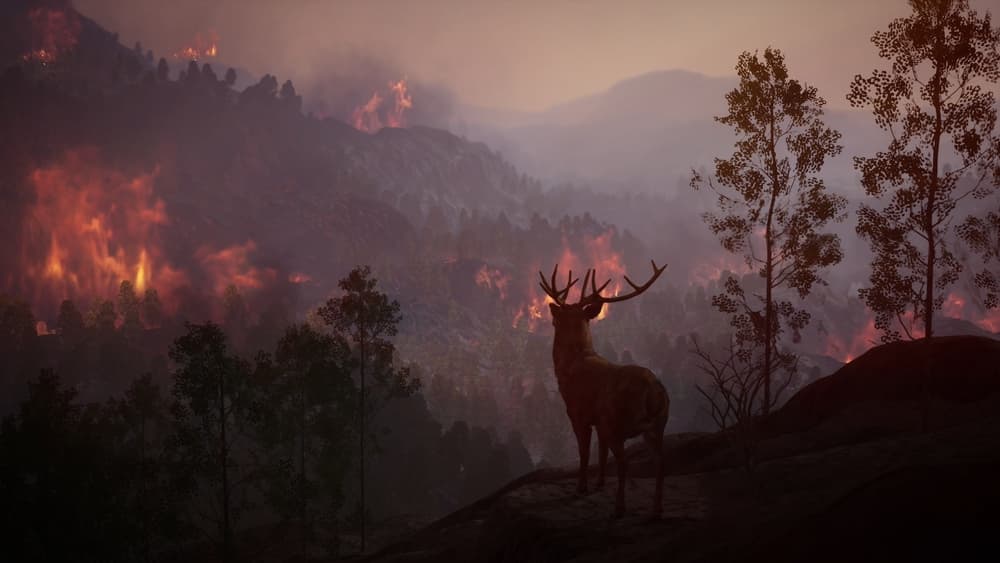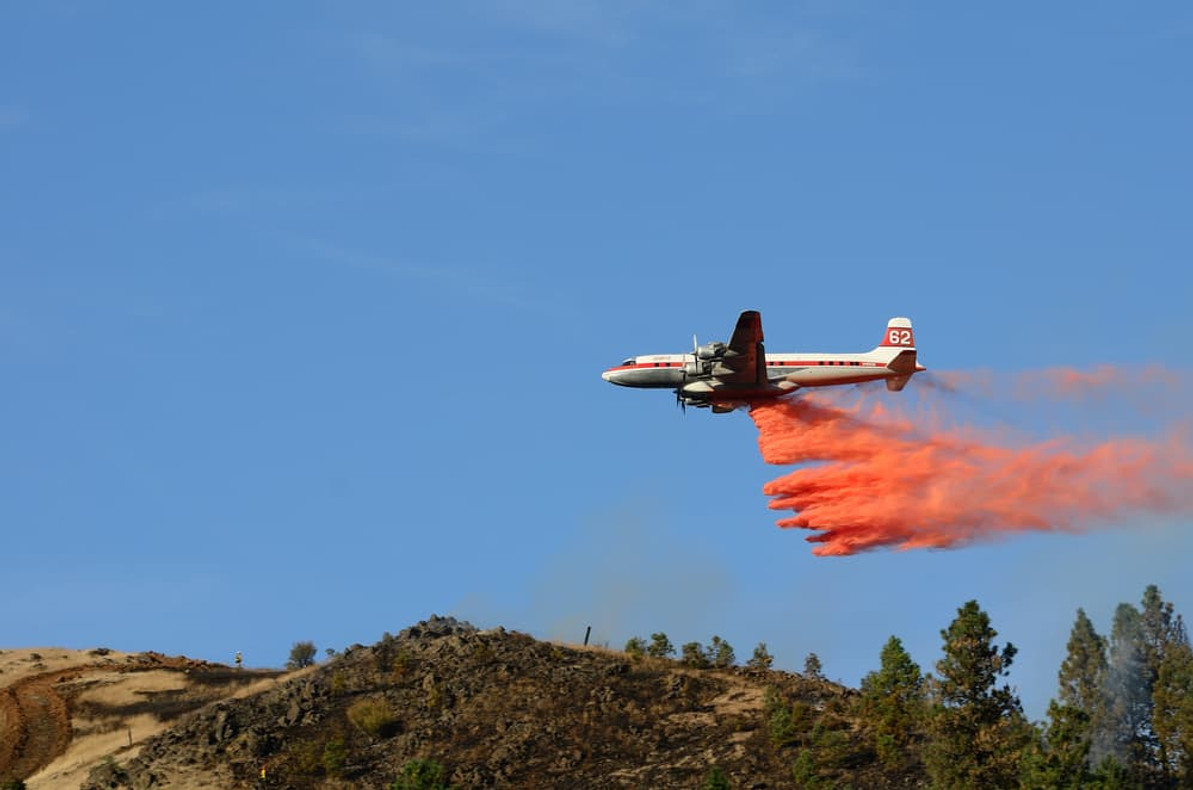What Is in Fire Retardants Dropped From Planes?
In the United States, firefighting strategies range from the ground to the air. Aerial firefighting is one of these strategies. It involves dropping water and fire retardant from planes to slow or stop the spread of a wildfire.
But what exactly is in fire retardants dropped from planes, and how do they work? In this blog, we'll look at:
- The chemical composition of fire retardants.
- Why they're essential for aerial firefighting.
- Their applications.

What Is Fire Retardant Made From?
Fire retardant is a mix of chemicals designed to help extinguish or slow the spread of wildfires. The exact ingredients can vary depending on the fire's fuel, as different chemicals are needed to combat other fuels.
Fire Retardant Ingredients
Generally speaking, fire retardants may contain the following fire retardant ingredients:
- Water
- Ammonium sulfate: a fertilizer used to reduce the fuel for fires.
- Potassium silicate: a mineral salt that reduces the combustibility of fuels
- Borates: they serve as a wetting agent
- Lignosulfonates are a byproduct of wood pulp production and act as an additional wetting agent.
- Gelling agents help adhere the fire retardant onto the fuel, allowing it to stick longer.
- Other additives may also be included depending on the fire. For example, as an anti-foaming agent to prevent it from developing suds on the surface. Also, an organic dye for easy tracking of its deployment.
Is Fire Retardant Dropped from Planes Toxic?
Fire retardants used in aerial drops contain ammonium phosphate or ammonium sulfate. These are effective in controlling wildfires but can pose environmental and health risks. These chemicals can disrupt soil and water ecosystems, potentially harming plants and aquatic life.
While exposure to diluted retardants is generally not acutely toxic to humans, it can irritate in some cases. Long-term environmental effects are still being studied. This makes it essential to use these chemicals carefully and avoid sensitive areas like waterways.
Fire Retardant’s Use in Aerial Firefighting
The purpose of a fire retardant is:
- To reduce the fuel for fires
- Prevent combustion
- Make it more difficult for a fire to spread
These chemicals, which are dropped from planes alongside water, are critical components of aerial firefighting for slowing or stopping the spread of wildfires.
Fire Retardants Can Be Deployed in Two Ways
Direct Attack
In a direct attack, fire retardant chemicals are dropped directly onto the active flames or burning areas to reduce the intensity of the fire quickly. This method works by lowering the combustion temperature and altering the chemical reactions within the fire, essentially smothering it and cutting off its fuel source.
Direct attacks are often used when there is an immediate threat to structures, infrastructure, or personnel on the ground, providing critical support to firefighters by slowing the fire’s spread and allowing ground crews to contain the blaze more effectively.
Indirect Attack
Indirect attacks involve dropping fire retardant chemicals on unburned areas ahead of the fire to create a buffer zone, also known as a firebreak. The chemicals coat vegetation, making it less flammable and significantly reducing the chance of ignition if the fire reaches that area.
This tactic is typically used when the fire’s path is more predictable. It allows firefighters to strategically position the retardant to prevent the fire from jumping to new areas. Indirect attacks are especially effective in difficult terrain or areas where direct attacks would be too risky or less effective.
Phos-Chek: The Fire Retardant Dropped From Planes
Every summer, we hear news reports of wildfires raging across the western United States. As firefighters work to contain these blazes, air tankers drop fire retardant on the flames to reduce their intensity.
Phos-Chek, a fertilizer-based liquid, is one of the most commonly used fire retardants dropped from planes. It is a direct firefighting agent that contains polymers, surfactants, water, and other additives.

How Does Phos-Chek Work?
Protection
The polymer helps create an aqueous film on the fuel and acts as a protective barrier. The surfactants help reduce surface tension. This allows the fire retardant to penetrate the surface, while the other additives help reduce flammability.
Reduces Intensity
This coating deprives the fire of oxygen and reduces its intensity. It allows firefighters on the ground to safely approach and extinguish the blaze with minimal risk of flare-ups due to wind changes or dry conditions.
Coating
The key ingredient in Phos-Chek is ammonium phosphate. It forms a thin coating over combustible materials. For example, wood or brush when applied via air tanker or helicopter bucket drops.
Other Ways to Use Phos-Chek
In addition to being dropped from planes, Phos-Chek can also be applied by hand or via ground vehicles.
Buffer Protection
Phos-Chek also acts as a buffer between vegetation and flame-generated heat. This helps protect trees, shrubs, and other foliage from burning up completely should they come into contact with fire.
Soil Nutrient Benefits
Additionally, since Phos-Chek contains fertilizer components (up to 11% nitrogen), areas affected by the fire will begin regrowing sooner. This is because beneficial nutrients are added directly into burned soil. This helps to prevent erosion caused by heavy rains post-fire season.
Find the Best Fire Retardant Products at RDR Technologies
For the highest quality fire retardants, trust RDR Technologies.
We offer a wide range of fire retardants and other fire protection products that can help slow or stop the spread of wildfires.
From our revolutionary Phos-Chek fire retardants to our non-toxic flame retardant sprays, we have what you need for your aerial firefighting needs.
Contact us today to find the best fire protection products for you.
Read Next
Learn How Can Fabric Be Treated With a Fire Retardant
What Can You Put on Wood Substrate to Make it Fire Resistant?
Is Spray Foam Insulation Fire Retardant?
Find Out How Long Fire Retardants Last
Fire vs. Materials: Is Leather Fire Retardant?
Fire vs. Materials: Is Polyester Flame Retardant?
Life-Saving Materials 101: What Fabrics Are Flame Retardant?
Recent Posts
-
Halloween Decor Safety: Protecting Costumes, Props & Haunted Houses with Fire Retardants
Halloween is one of the most creative holidays of the year. From glowing jack-o’-lanterns to elabora …Nov 5th 2025 -
Cost-Benefits of Investing in Fire Retardant Coatings
In today’s construction and safety-conscious environment, protecting buildings, assets, and people h …Nov 5th 2025 -
Fire Resistant vs Fire Retardant vs Intumescent: What's The Difference
When it comes to fire safety, the terms fire-resistant, fire-retardant, and intumescent are often us …Nov 5th 2025




